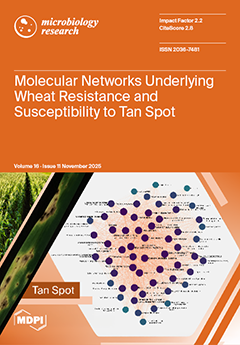Helicobacter pylori is a gastric pathogen that induces chronic gastritis, which may progress to neutrophilic activity, glandular atrophy, intestinal metaplasia, and gastric carcinoma. The aim of this study was to evaluate
H. pylori-induced tissue damage. A total of 602 gastric biopsy samples
[...] Read more.
Helicobacter pylori is a gastric pathogen that induces chronic gastritis, which may progress to neutrophilic activity, glandular atrophy, intestinal metaplasia, and gastric carcinoma. The aim of this study was to evaluate
H. pylori-induced tissue damage. A total of 602 gastric biopsy samples were collected, categorized, and analyzed using hematoxylin and eosin and Giemsa staining, followed by molecular confirmation through PCR targeting the species-specific 16S rRNA gene.
H. pylori density and histopathological features were evaluated and graded according to the updated Sydney classification system.
H. pylori was detected in 55% (
n = 334) of cases, and the antrum (50.83%,
p < 0.00001) was the predominant site. A slightly higher prevalence was observed in females, accounting for 56.9% compared to males at 43.1%, which was attributed to sociocultural exposure differences. Individuals aged 11–40 years accounted for 58.3% (
n = 195), highlighting early-age acquisition of infection.
H. pylori infection was significantly linked to moderate-to-severe inflammation (63.2%,
p < 0.00001) and neutrophilic activity (53.3%,
p < 0.00001). Intestinal metaplasia and atrophy were infrequent, present in 0.6% (95% CI, 0.02,
p = 0.149) and 0.9% (95% CI, 0.05,
p = 0.430) of individuals.
H. pylori infection causes chronic inflammation and neutrophilic infiltration of the stomach mucosa. Early identification and histopathological examination are essential in assessing
H. pylori-related gastric pathology.
Full article





